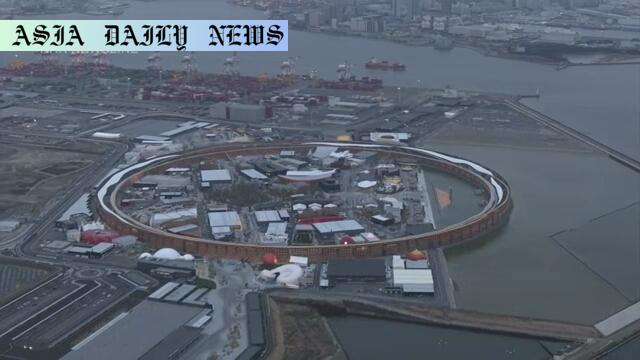Expo 2025 unveils futuristic exhibits and EV buses, but concerns remain with only eight of 42 country pavilions completed.

Introduction: The Countdown to Expo 2025
With only a month remaining until the highly anticipated kickoff of Expo 2025 in Osaka, excitement is bubbling in western Japan. Scheduled to commence on April 13, this global event aims to be a celebration of creativity, cutting-edge technology, and cultural exchange. The venue, a man-made island called Yumeshima, has been meticulously prepared to host millions of visitors over six months. However, not everything is completely ready, and there are mixed opinions on the Expo’s readiness and ultimate success.
Futuristic Exhibits and Innovative Concepts
The Expo promises jaw-dropping innovation, starting with the unveiling of electric vehicle (EV) buses that can operate autonomously under specific conditions. These buses aim to transform transportation while reducing environmental impact. Additionally, several pavilion exhibits were previewed for the media, including an elaborate showcase of a “Future City” concept designed by 12 renowned Japanese companies and groups. This vision includes high-tech transit systems, featuring seamless integration of planes and trains to revolutionize urban mobility.
Another standout pavilion boasts an egg-shaped exterior that is as intriguing as its contents. Inside, visitors will learn about cutting-edge energy technologies aimed at powering tomorrow’s world. These exhibits not only showcase technological advancements but also reflect Japan’s ongoing commitment to sustainability and innovation.
Anticipation and Personal Stories
The Expo has already sparked enthusiasm among locals and visitors alike. Yamada Tomiyo, who rented an apartment near the site, expressed her excitement about attending the event daily. “I want to meet different people and visit all the pavilions,” she said. Yamada’s sentiment epitomizes the global spirit of the Expo, dedicated to fostering connections and world culture appreciation.
However, this enthusiasm is not shared universally. Some residents and prospective visitors have raised concerns about the readiness of the event. As of now, only eight of the planned 42 country pavilions are complete, casting doubt over the organizers’ ability to deliver a fully operational Expo by the launch date. Despite these challenges, the Expo remains poised to be a groundbreaking event, showcasing the intersection of technology and cultural diversity.
Challenges in Ticket Sales
Another obstacle for Expo 2025 organizers is slower-than-expected ticket sales. Officials initially aimed to sell 14 million advance tickets, but as of March 5, only 8 million have been purchased. This gap has raised questions about public interest and the broader economic feasibility of the event. Given the scale and ambition of Expo 2025, the pressure to boost ticket sales is mounting in the final weeks leading up to the opening ceremony.
Bringing the World Together
Despite the setbacks, Expo 2025 carries the potential to bring the world together under one roof—or rather, across various pavilions. With over 42 participating countries and countless exhibits, the event offers invaluable opportunities for cultural exchange, innovation sharing, and global collaboration. The themes of sustainability, technological advancements, and future-focused solutions remain at the heart of the Expo, ensuring it becomes a lasting legacy for Osaka and the world.
Conclusion: The Promise of Expo 2025
As the countdown continues, the excitement surrounding Expo 2025 is palpable, even amid challenges. The event remains a beacon of innovation, fostering curiosity and understanding among diverse audiences. Whether it’s autonomous EV buses, futuristic cityscapes, or groundbreaking energy technologies, Expo 2025 is set to be a milestone in showcasing what the future holds. As Osaka prepares to host millions of visitors, all eyes are on the organizers to deliver an unforgettable, world-class experience.
Commentary
Expo 2025: A Beacon of Innovation and Challenge
Expo 2025 is undoubtedly set to become a landmark event, showcasing the best of human ingenuity and international collaboration. The previews thus far suggest an awe-inspiring showcase that merges sustainability, innovation, and cultural exchange. From autonomous EV buses to futuristic urban concepts, the Expo is surely a reflection of humanity’s bold vision for tomorrow. I’m particularly intrigued by the “Future City” exhibit, as it represents not just technological possibilities but also a roadmap for a sustainable and connected world.
Concerns of Readiness
While the promise of Expo 2025 is significant, there are concerns regarding its readiness. The completion of only eight out of 42 country pavilions raises questions about logistical challenges and potential compromises. It’s vital for stakeholders to work tirelessly in the coming weeks to address these issues. After all, an event of this magnitude needs to function smoothly to meet global expectations and ensure a fulfilling experience for its visitors. The shortfall in ticket sales is another hurdle that demands immediate attention. Effective last-minute marketing campaigns and incentives may help boost attendance significantly.
Expo’s Legacy and Global Impact
Despite the hurdles, I firmly believe that Expo 2025 holds immense potential as a unifying event. In a world often marked by division, events like these remind us of shared goals and the incredible power of innovation. The Expo offers not merely a glimpse into the future but also a platform to confront and solve present-day challenges collaboratively. As an event that brings together nations, organizations, and individuals from varying disciplines, Expo 2025 has the potential to redefine our collective aspirations. Ultimately, its success or failure will serve as a testament to global cooperation’s potential.


